They are all big, scaly air-breathers encased in streamlined shells, but don’t let that fool you into thinking that the seven living species of sea turtle are very similar animals. Having diversified for 200 million years, they have evolved different ways of surviving on a planet that has undergone massive upheavals during their tenure. Each species is a unique testament to nature’s inventiveness.
Green Turtles
I thought my opportunity had arrived. I needed a photo of turtles mating for my book, and just across a short stretch of glassy calm sea I spotted a pair of green turtles upright at the surface. I slipped into the water and snorkeled slowly toward the courting couple. Their belly-to-belly orientation was a clue that the female was not interested in the male. By facing off with a male, a female can prevent him from mounting her. This male was attempting to overcome her resistance by slapping her around with his large pectoral fins, each armed with a heavy-duty curved claw. These talons are used to hook onto the forward edges of the female’s carapace (upper shell) during mating, which enables the male to maintain his position for marathon coupling sessions that can last for hours or even days.
The two turtles were so intensely focused on their competition that they did not notice as I quietly finned up to within camera range. But when my shutter closed with a “clack,” the female turned to look at the strange creature that was now only 3 feet away from her. Deciding she wanted no part of me, she took one breath and dove for the depths. Male turtles in the mood, however, are notorious for their lack of discrimination. This one looked momentarily frustrated over the sudden disappearance of the object of his ardor, but then he turned to look at me with an expression that seemed to say, “It’s too bad she’s gone, but I guess you’ll do.”
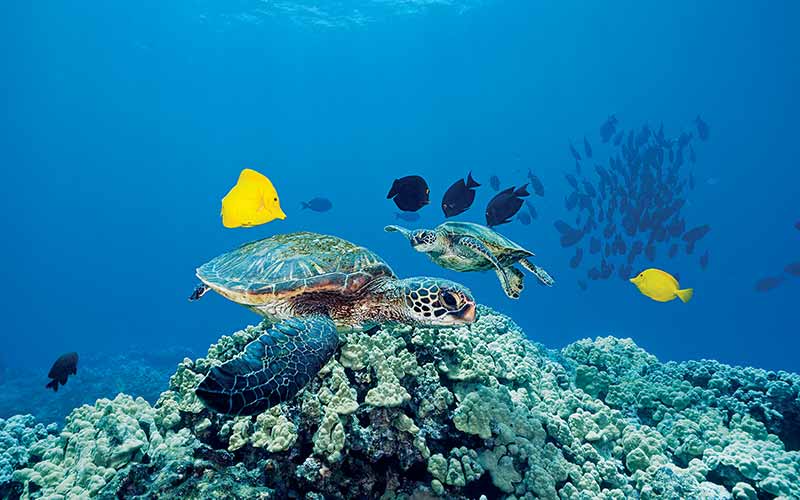
The next thing I knew, those clawed flippers were smacking my face as I tried to push away the turtle with my camera and fins while waving frantically to the boat for a pick-up. My boat boys waved back happily, as if to say “Hello to you, too.” The few hundred yards separating me from sanctuary now seemed like the vast expanse of water between Moses and the Promised Land. I eventually climbed aboard with my virtue intact, but I resolved to never again underestimate the persistence and brute strength of this Don Juan of the animal kingdom.
I eventually succeeded in photographing green turtles mating in stacks of two, three and even four. Male sea turtles are rarely discouraged by the fact that another male has already mounted a female. Green turtles have distinguished their species not only with the longest recorded fornications but in many other aspects of their lifestyle and biology as well.
Green turtles are the only sea turtles that are primarily herbivores as adults. On a diet consisting mostly of seagrasses and algae, they grow to the second largest size of any sea turtle, achieving a maximum weight of 517 pounds. They are also the only sea turtles that spend time ashore (beyond the time spent by egg-laying females). In a few locations and for reasons that have not been fully elucidated, green turtles of both sexes regularly drag themselves up onto the beach and spend hours basking on dry land.
Green turtles exist throughout the tropics and subtropics and are therefore perhaps the species most familiar to divers. They grow larger than hawksbill turtles, the other species most commonly seen on coral reefs, and have a shell with a smooth margin compared to the jagged edges of hawksbills’ carapaces. The plates that make up green turtles’ shells are smoothly joined rather than overlapping like the plates of hawksbills’ shells. Their beaks are blunter than the pointy, birdlike beaks of hawksbills, and the green is the only sea turtle with a beak that’s serrated. The jagged, toothlike serrations are useful for clipping off blades of seagrass. The green turtle is also the only sea turtle with a single pair of long scales on the forehead. Most other sea turtles have two pairs of round or square scales on the forehead.
Hawksbill Turtle

Hawksbill sea turtles are found on coral reefs and in other tropical habitats around the world. Their diet is even more unusual than that of green turtles: They feed primarily on sponges, which are full of noxious compounds and are often reinforced with needles of silica or other hard substances, which leads researchers to describe hawksbills as having a “diet of glass.” Hawksbills are sometimes seen tearing apart a section of reef to get at the sponges growing among the coral rubble.
While green turtles can also have beautifully patterned shells, it is the carapace of the hawksbill turtle that provides the easily worked material for tortoiseshell jewelry. In young hawksbills, the scutes (scalelike plates) that make up the carapace overlap and produce a very jagged margin, especially at the rear of the carapace. In older hawksbills, however, the carapace margin can be smooth, and there is little overlap of scutes. Hawksbills can be recognized by their slender heads and pointy, birdlike beaks.
Loggerhead Turtles
The third species of sea turtle likely to be seen by divers is the loggerhead. The big, blocklike head of this species distinguishes it immediately from other sea turtles and provides a clue about its feeding habits. While the serrated jaws of the green turtle are designed for snipping off blades of grass and strands of algae, and the sharp, narrow beak of the hawksbill is well adapted for reaching into crevices in the reef to scrape off sponges, the massive jaws of the loggerhead enable it to crush shelled invertebrates such as crabs, lobsters, scallops, conchs and urchins. An adult loggerhead can crack a thick conch shell that is difficult to chip with a hammer.
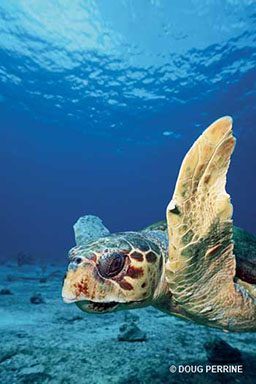
Naturally you would not want to have the industrial-strength feeding apparatus of a 400-pound loggerhead closing around any of your body parts, which is why I once found myself swimming as fast as I could in tight circles around the wreckage of an old ship with a large turtle in hot pursuit. I had violated one of the two cardinal rules of wildlife interaction — don’t touch and don’t feed — and I was paying the price. To facilitate the filming of the feeding behavior of this species for a documentary on marine wildlife, I had pulled some hidden shellfish out of the wreck and placed them on the seafloor in front of the turtle. The technique worked well for a few takes, but then the pea-sized reptilian brain of the turtle made the connection between tasty food and the guy in the red wetsuit. Soon the cameraman and lighting assistant were laughing too hard to operate their equipment as they watched me over-breathing my regulator in a panic while trying to outmaneuver the hungry giant.
Another distinguishing characteristic of loggerheads is the color of their shells and skin, which tend toward shades of brown with tones of orange, red or yellow. This is in contrast to the more green, gray and brown color schemes of hawksbill and green turtles. If you are in doubt, the species identification can be confirmed by counting the large scutes on either side of the carapace. There are five lateral scutes on the shell of a loggerhead but only four on green and hawksbill turtles. The loggerhead’s carapace is also longer and more spindle-shaped than the rounder shells of greens and hawksbills.
While all sea turtles are migratory to some extent, loggerhead turtles are simply phenomenal in this regard, regularly crossing the Pacific Ocean between breeding and feeding areas. This is one of the longest migratory paths known in the animal kingdom — about one-third of the distance around the earth.
Leatherback Turtles
Leatherbacks are champion swimmers, wandering thousands of miles as they hunt for dense concentrations of drifting jellylike organisms in the open ocean. Because leatherback turtles feed in deep water and usually approach shore only to nest, divers rarely see them. For anyone lucky enough to see one, the huge size and unusual appearance of the leatherback should leave little doubt about its identity. The shell is covered with smooth skin rather than hard scutes, and it has seven prominent longitudinal ridges on the upper surface. The body is nearly black with irregular white splotches, and it’s even more spindle-shaped than the loggerhead’s. The flippers are enormous, spanning up to 9 feet. Instead of a hard beak, like other sea turtles, the leatherback has a muzzle with an M-shaped opening, suitable for slurping down large quantities of gelatinous prey. Spiky projections inside the mouth and throat keep the jellies from swimming back out again.
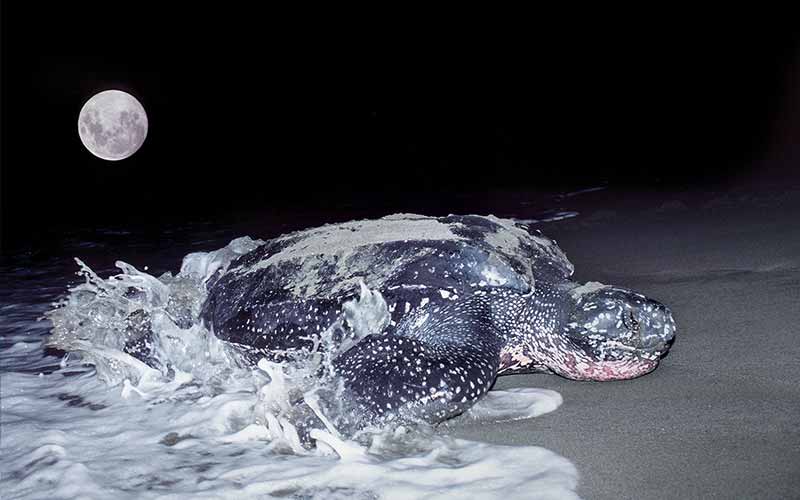
Leatherbacks are so different from all other sea turtles that they are classified in a separate family. Incredibly for an animal whose diet consists of creatures that are 95 percent water, they grow much faster and larger than other sea turtles, attaining lengths of nearly 10 feet and weights of up to a ton. They achieve this prodigious growth by feeding around the clock, whereas most sea turtles are active by day and rest at night. To find dense concentrations of sea jellies, leatherbacks dive to depths of more than 3,900 feet, which rivals the capabilities of sperm whales and elephant seals.
Unlike other sea turtles or any other living reptiles, leatherbacks are semi-warm-blooded, able to maintain a body temperature at least 32°F higher than the surrounding water temperature. This enables them to withstand the near-freezing temperatures of the dark depths where they hunt and to feed in frigid, high-latitude waters where other turtles cannot survive. A higher internal temperature facilitates faster digestion and a higher metabolic rate, which fuels their fast growth and early maturation. Leatherbacks are estimated to begin breeding at an age of 13 to 14 years, compared with 20 to 50 years for green turtles.
Olive Ridley Turtles
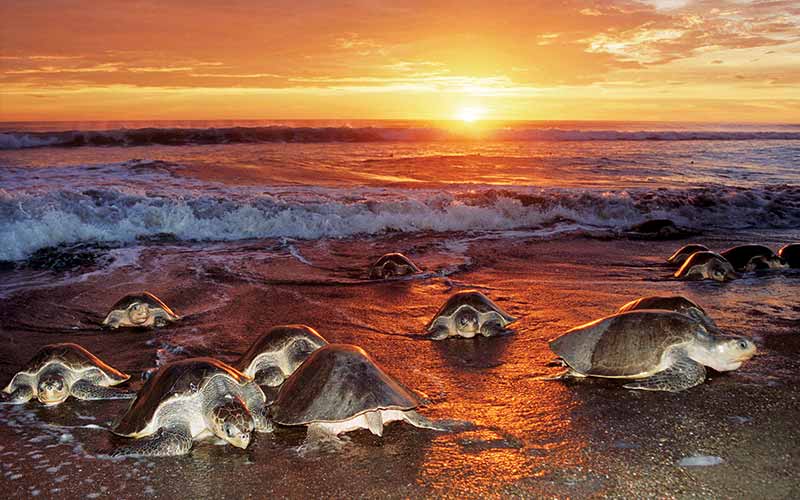
Divers do not often encounter olive ridleys, as these turtles do not frequent coral reefs but usually feed either in soft-bottom areas or in open ocean. However, they can be viewed on shore in one of nature’s greatest spectacles. While other types of sea turtle may share preferred nesting beaches with other members of their species, the act of nesting is a solitary event; not so with the two species of ridley turtles, which coordinate their nesting in mass events known as arribadas. During an arribada, which may last for days, hundreds of thousands of female turtles may come ashore on a single stretch of beach with hundreds or thousands digging nests simultaneously. Eggs may go flying through the air as turtles dig up nests previously laid by other turtles.
Olive ridleys are the smallest sea turtles, reaching a maximum weight of only 106 pounds. Adults have a nearly round carapace that is gray, brown or olive in color. The carapace has five to nine lateral scutes (usually six or seven), compared with four or five in other species.
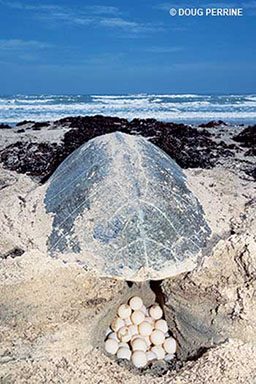
Kemp’s Ridley Turtles
Kemp’s ridley turtles are very similar to olive ridleys, growing only two pounds larger, but they are usually lighter in color and have only five lateral scutes. Historically, Kemp’s ridleys also nested in large arribadas, but this occurred at only one remote beach in the Gulf of Mexico — a location unknown to turtle researchers until 1963, by which time the population had been nearly wiped out by egg collectors.
Kemp’s turtles are currently the rarest and most endangered of all sea turtles. Before 1963, scientists were not even sure that this was a valid species, as they were not known to reproduce. Adults are found almost exclusively in the Gulf of Mexico, although juveniles may travel to the North Atlantic. An unknown number were killed in BP’s 2010 Deepwater Horizon oil spill in the Gulf of Mexico.
Sightings by divers are very rare, although a very small number have been spotted on Florida reefs. Kemp’s ridleys specialize in feeding on crabs, unlike olive ridleys, which feed on a wide variety of marine organisms. Kemp’s ridleys are the only sea turtles that nest more often by day than by night.
Australian Flatback Turtles
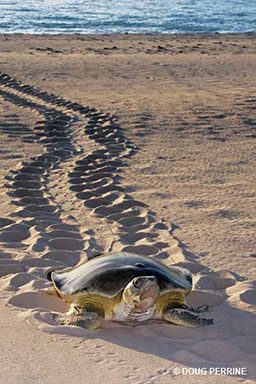
Australian flatback sea turtles are considerably more abundant than Kemp’s ridleys, but are even less likely to be seen by divers. The first underwater photographs of an adult flatback were published in 2012. The distribution of this species is even more restricted than that of Kemp’s ridleys. Because they have a life history that is drastically different from other sea turtle species, flatbacks are found only in the tropical and subtropical areas of the Australian continental shelf. All other sea turtles swim out to sea after hatching from eggs laid on a beach, and they spend years drifting and swimming in the open ocean before most settle into coastal habitats as juveniles (though leatherbacks and some olive ridleys and loggerheads stay in the open ocean). Flatbacks, however, stay in coastal waters after hatching and never disperse to the open sea.
All sizes of these strange turtles prefer silty, nearshore waters inhabited by saltwater crocodiles and deadly jellyfish — environments not conducive to in-water observations. Apart from their nesting behavior, little is known about them, including when and where they mate. Some researchers have never even seen a male. Their dietary preferences are unknown, although the few stomachs that have been examined contained a variety of marine invertebrates.
Flatbacks grow to about twice the size of ridley turtles, maxing out at 213 pounds. They are generally lighter in color than other sea turtles and have a carapace with a distinctive upturned brim. Researchers believe flatbacks can move faster on land than other sea turtles, as survival of the nesting females sometimes requires them to outrun saltwater crocodiles.
Astonishing Variety
The world’s sea turtles are a far-ranging, deep-diving, long-enduring and truly diverse group of animals. Some are carnivores; others are herbivores. Some are pelagic, while others are coastal. Most are cold-blooded, but some are partially warm-blooded. They represent not only different species but also different genera and even different families.
The sea turtles inhabiting today’s oceans aren’t different from each other like Hereford cows are different from Jerseys; they’re as different as cows are from dogs. Don’t be content just to see “a turtle” — I hope you see a hawksbill or a loggerhead or, with a bit of luck, something as rare as a leatherback.
© Alert Diver — Q3 Summer 2013